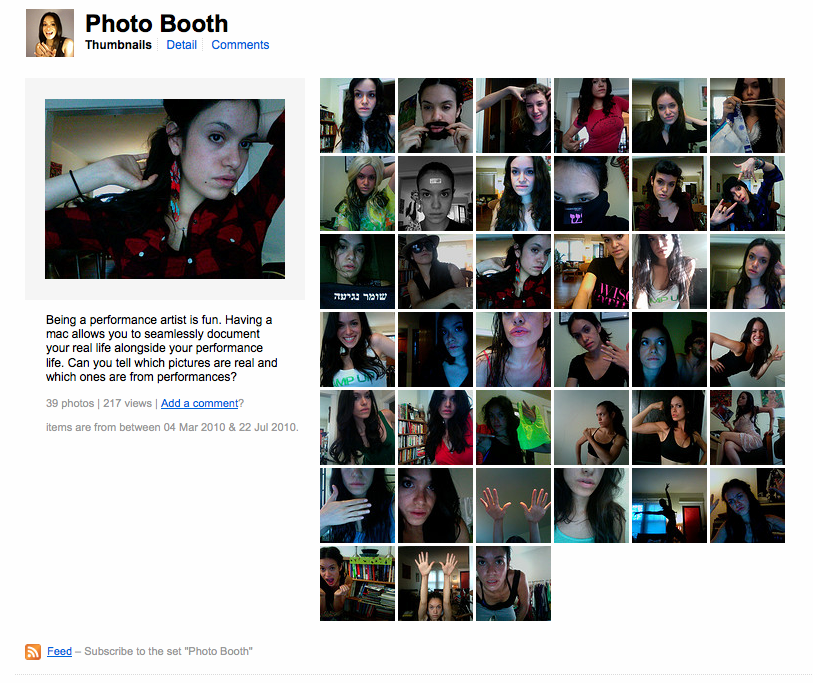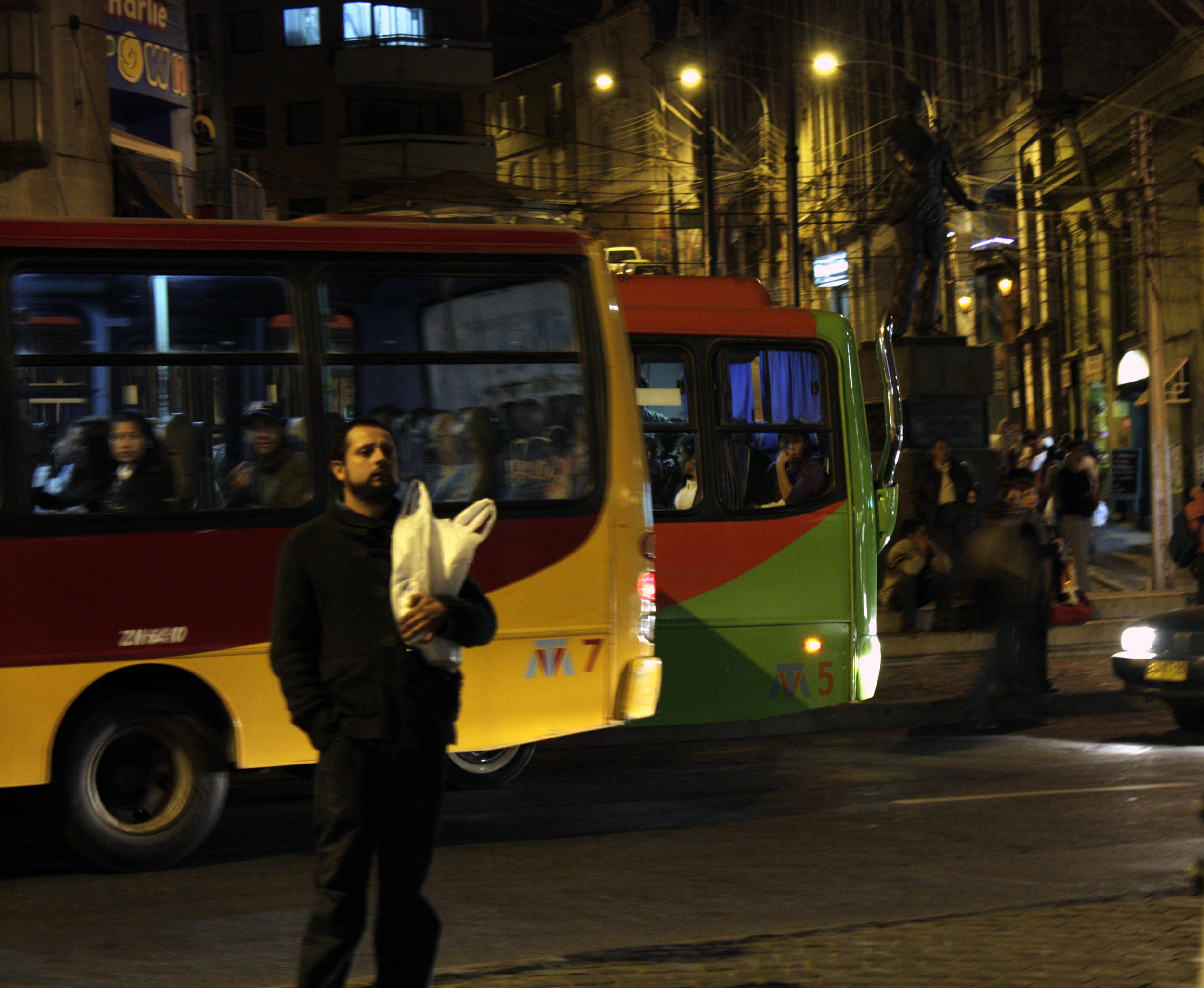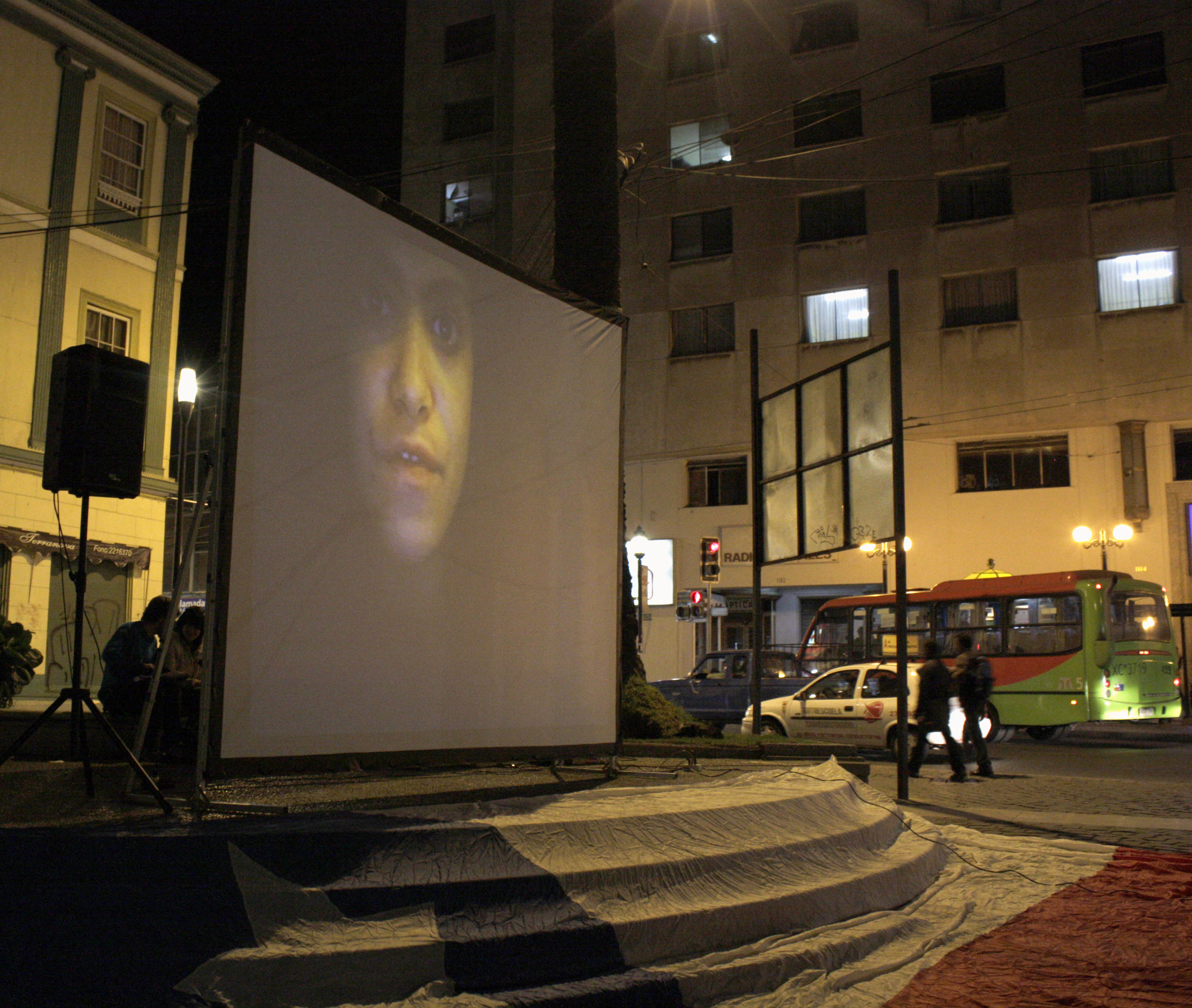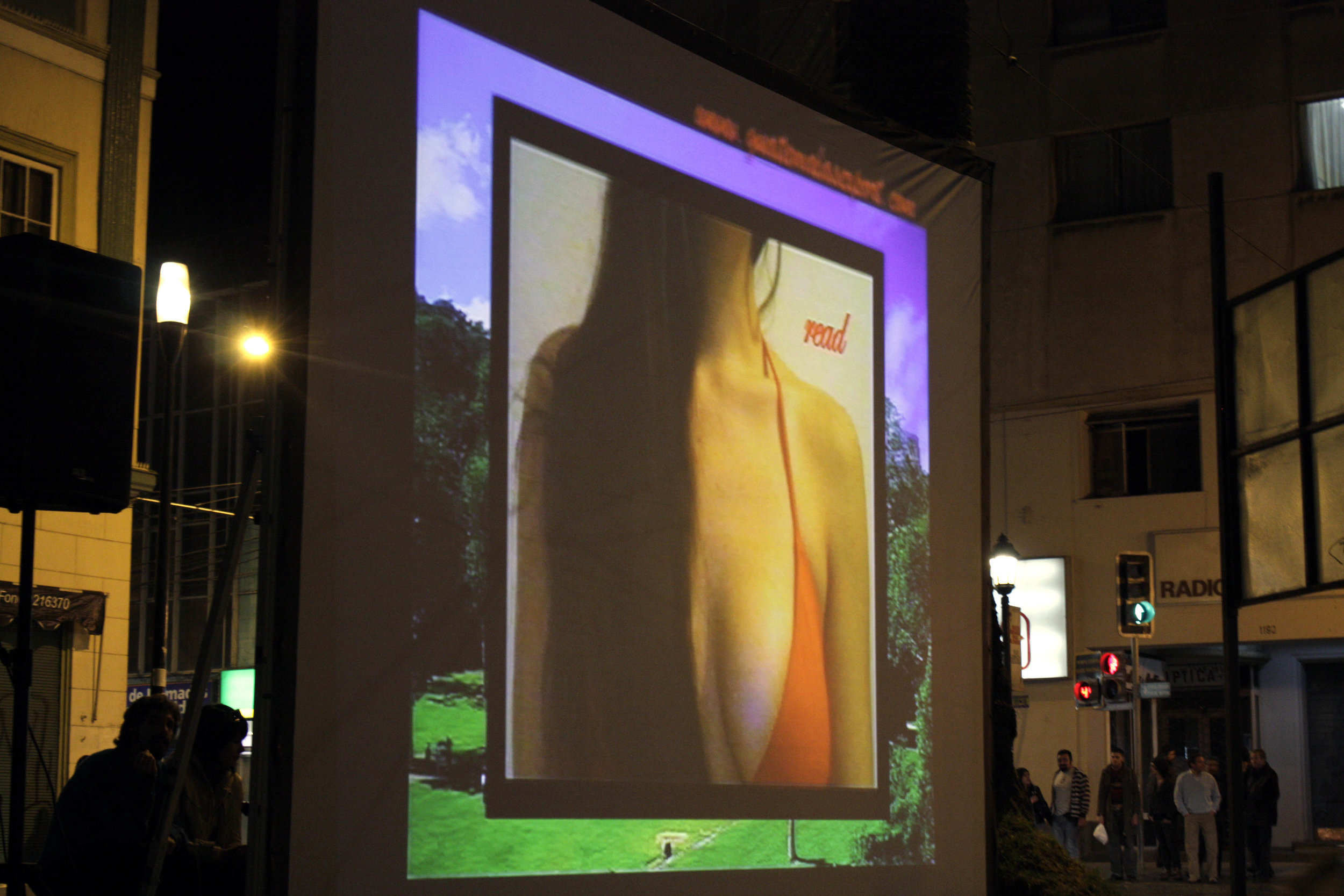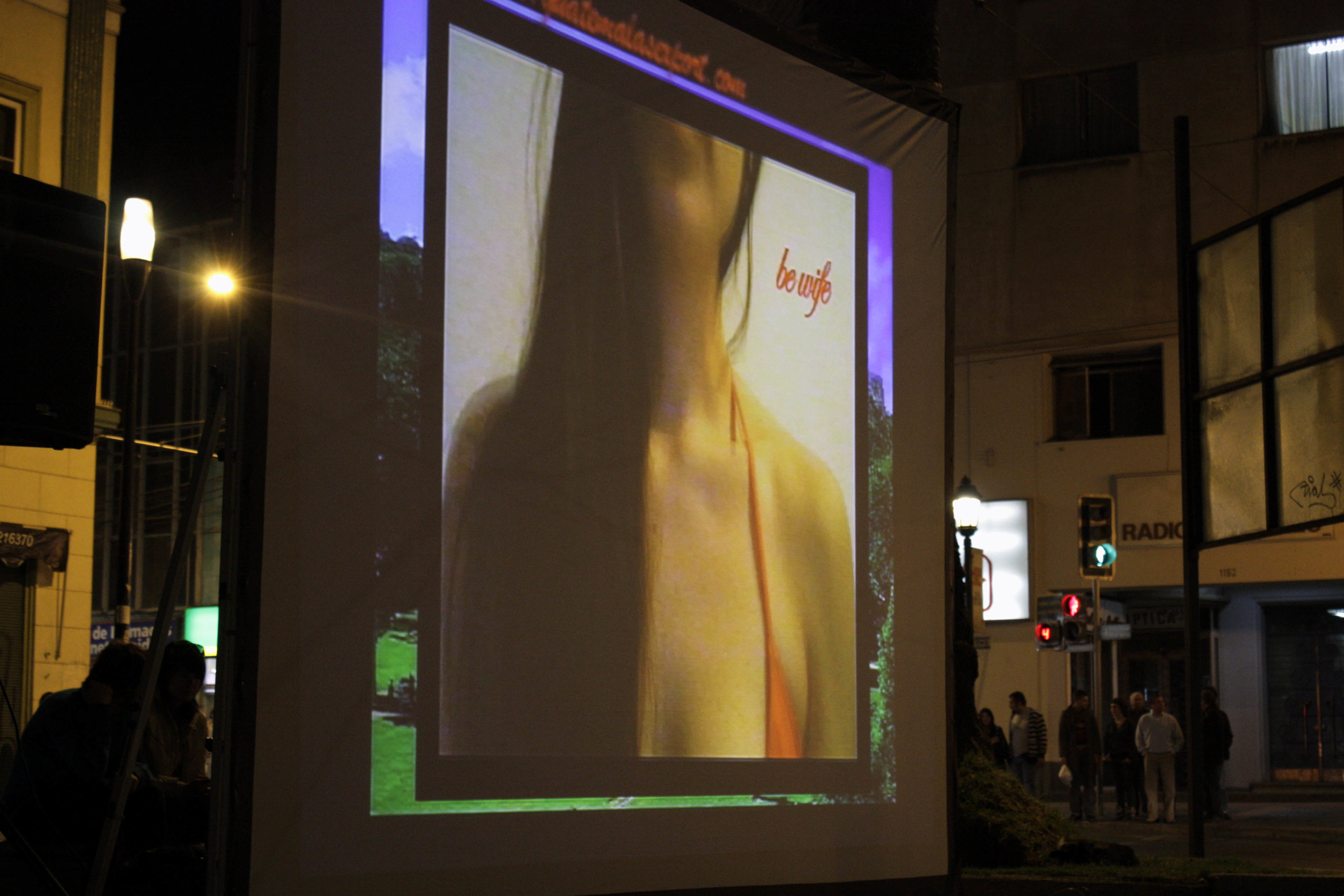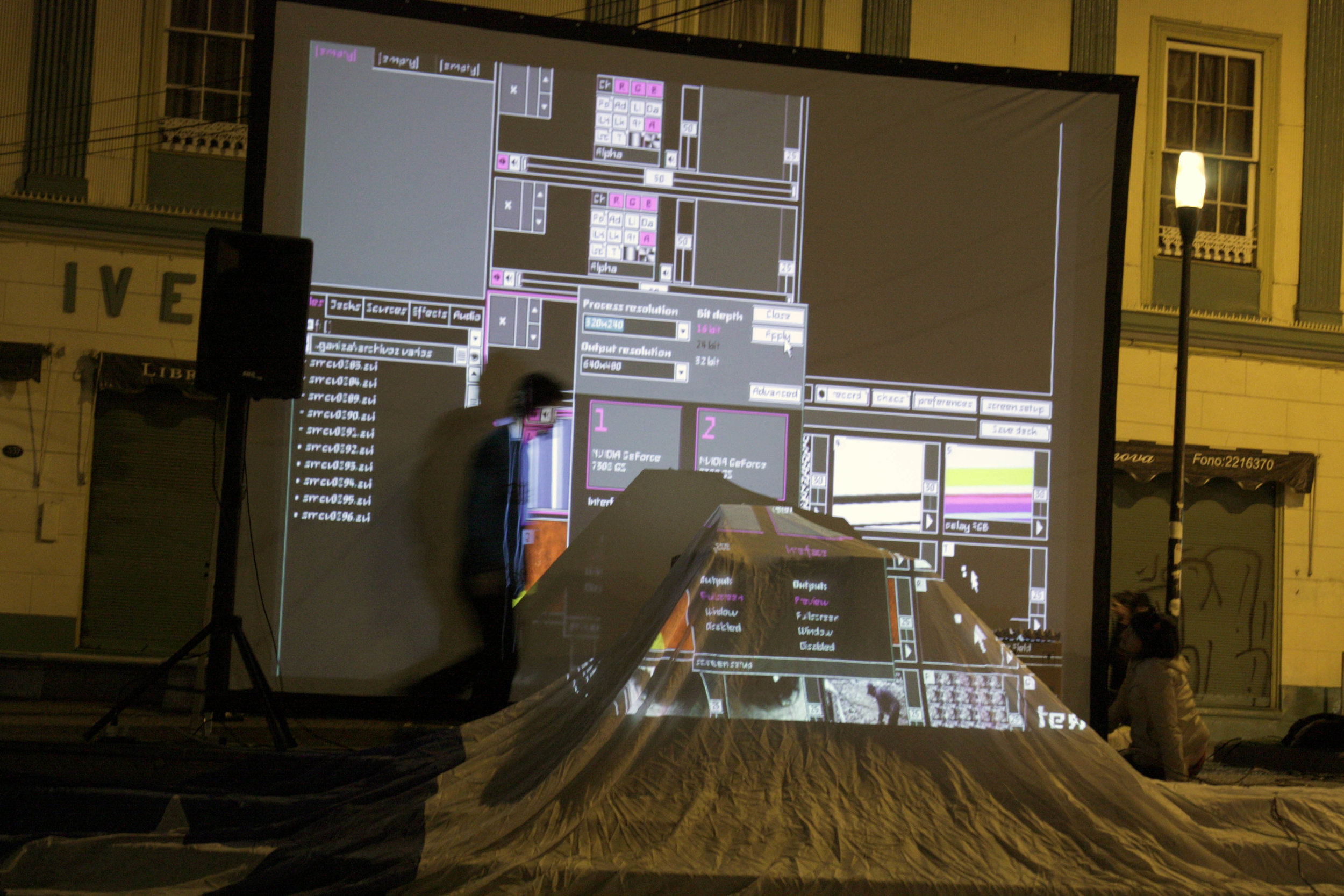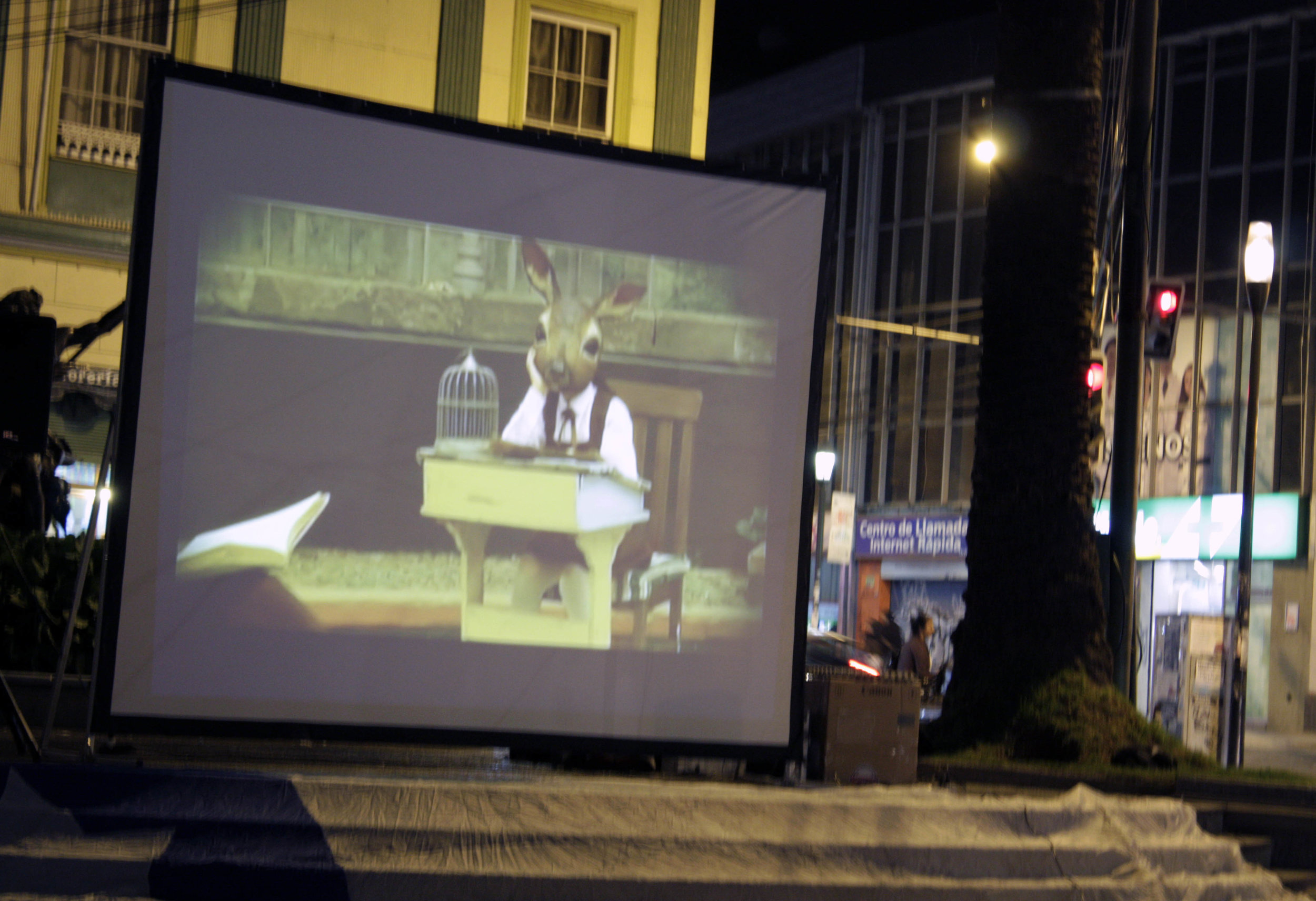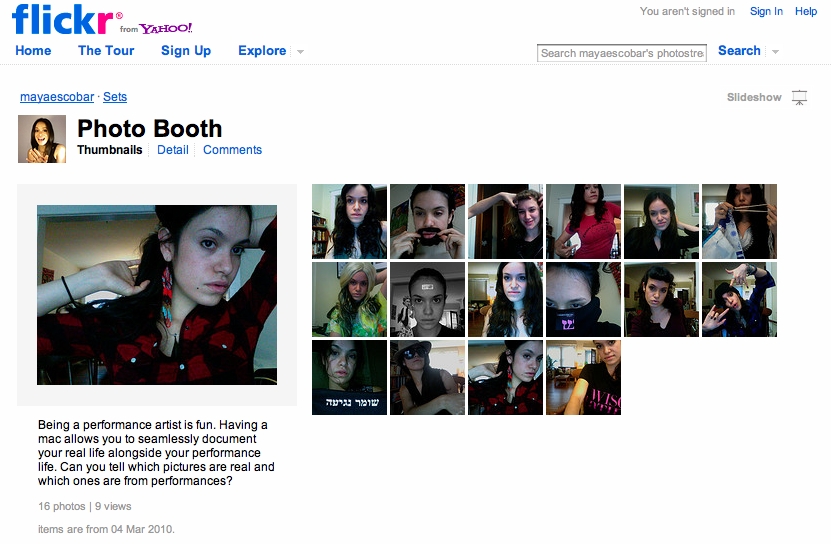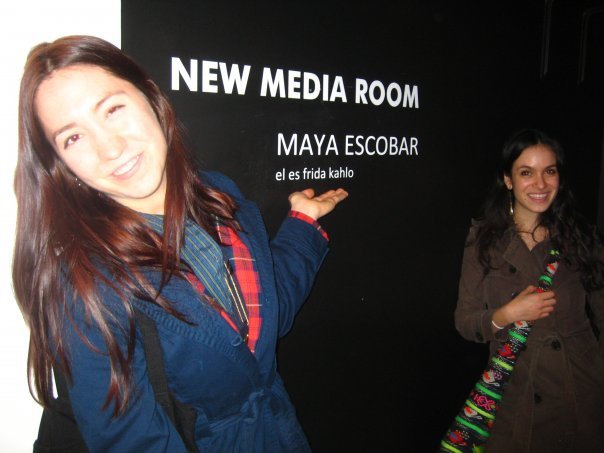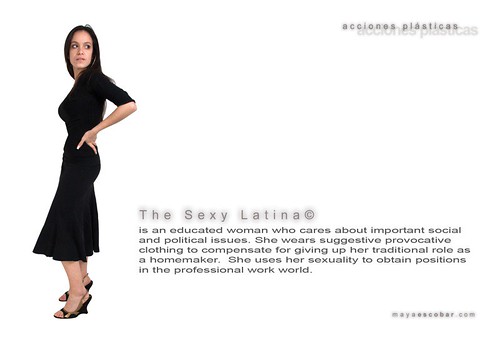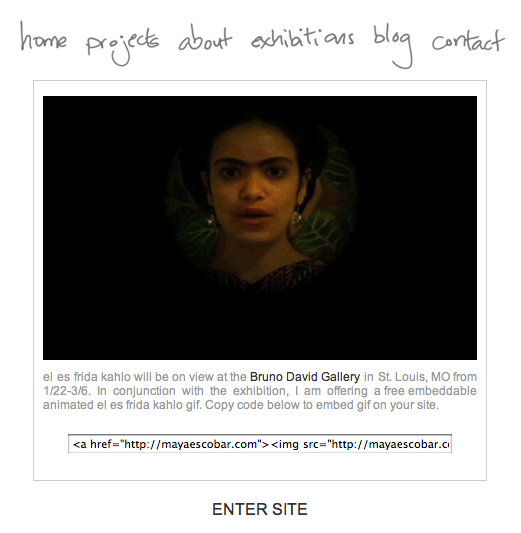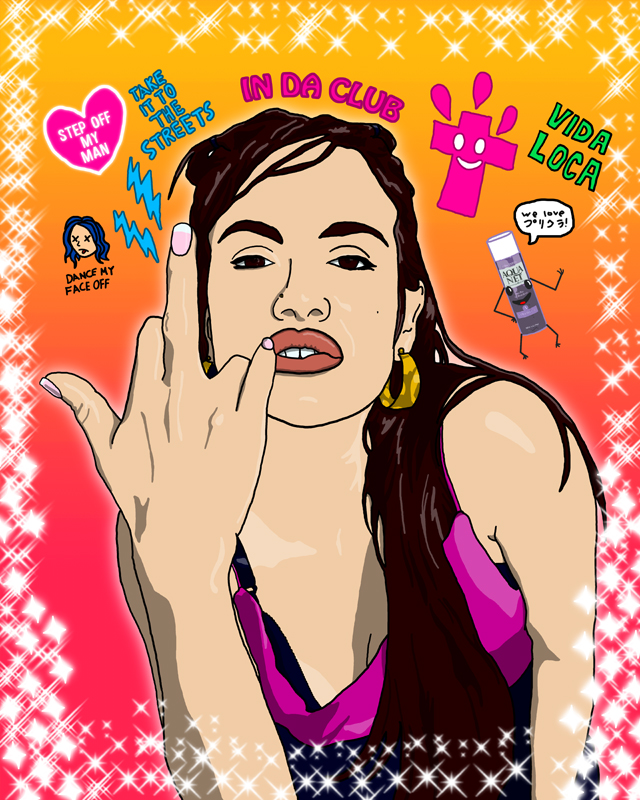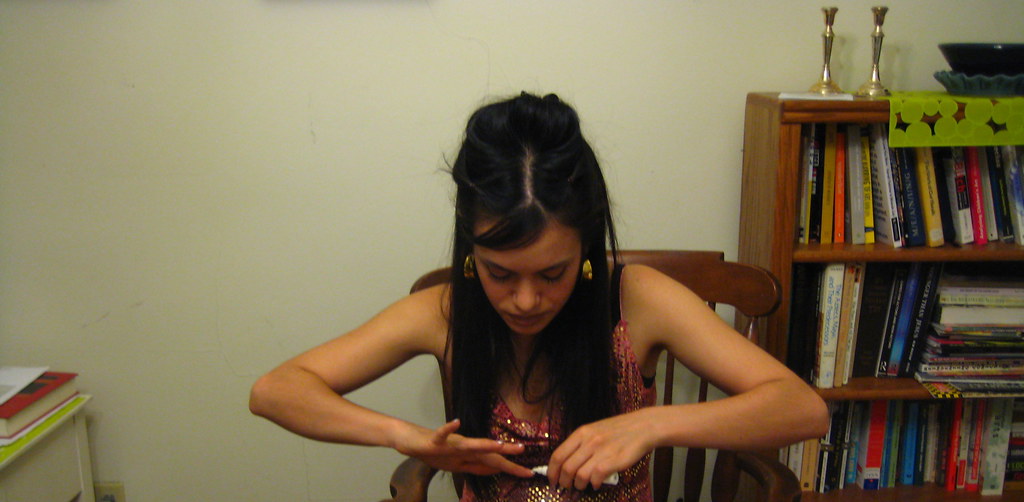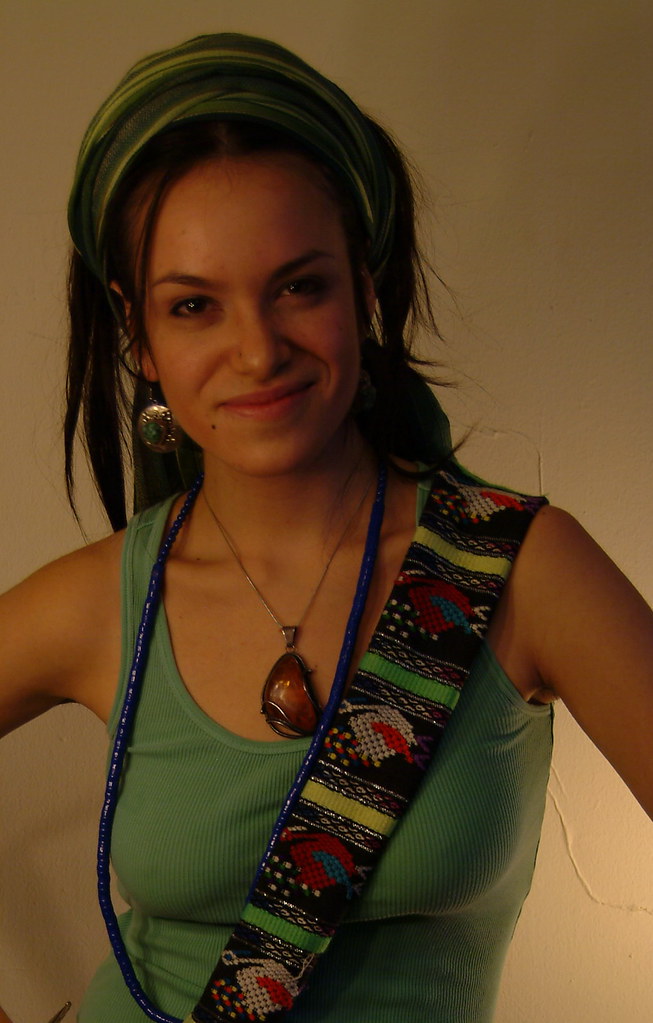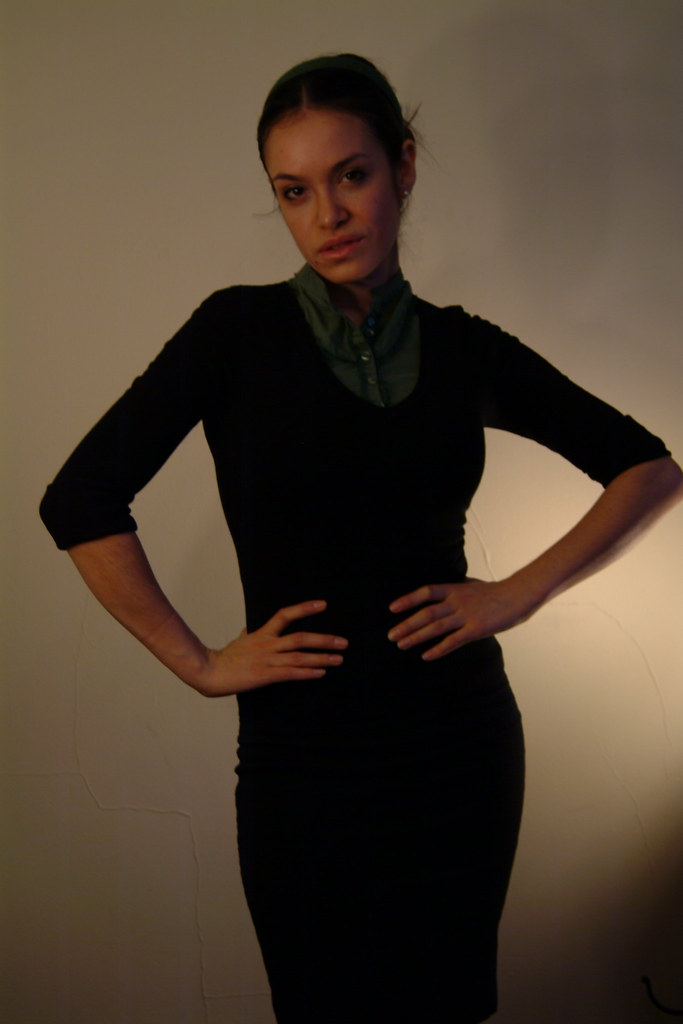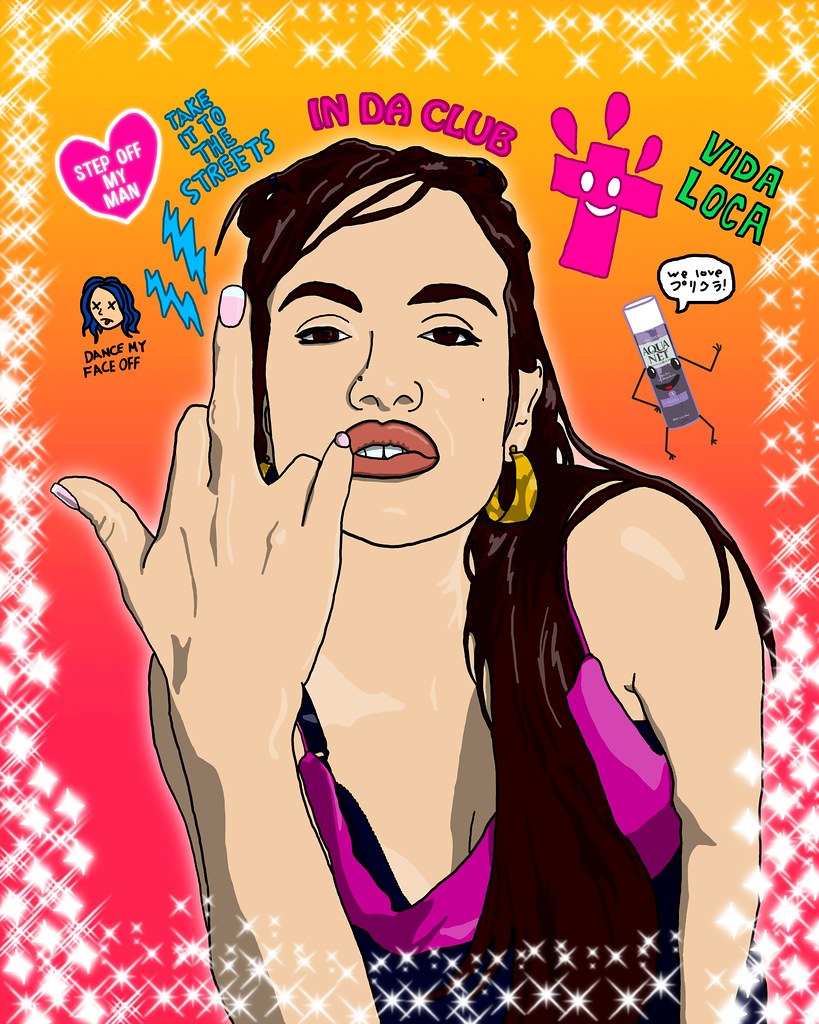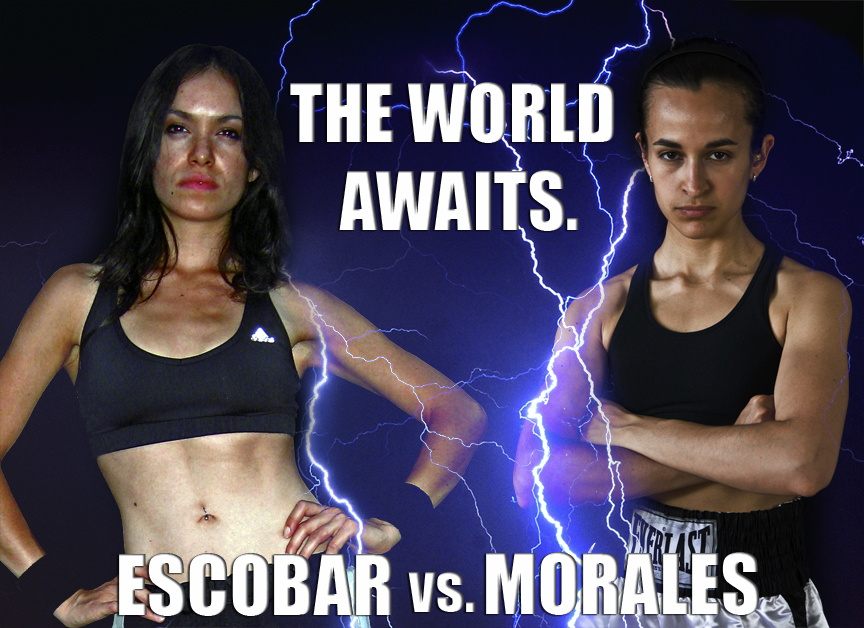 Artist Statement and BioEscobar-Morales is a team comprised of Maya Escobar and Andria Morales. The two artists, based in Chicago and Philadelphia respectively, have been working together over the Internet since 2010. They produce digital media and performance art that explores the role of self-representation in visual culture and its ability to deconstruct ingrained ideological conventions. By locating their performances online where they are free from restrictions of time and place, Escobar-Morales is able to concurrently enact multiple personas while simultaneously creating a unified hybrid self.Maya Escobar was born in Chicago, IL in 1984. Andria Morales was born in 1982 in New York, NY. Escobar received a BFA from the School of the Art Institue of Chicago (2007) and an MFA from Washington University in St. Louis (2009); Morales received a BA from the University of Pennsylvania (2004) and an MFA from Tyler School of Art, Temple University (2008).
Artist Statement and BioEscobar-Morales is a team comprised of Maya Escobar and Andria Morales. The two artists, based in Chicago and Philadelphia respectively, have been working together over the Internet since 2010. They produce digital media and performance art that explores the role of self-representation in visual culture and its ability to deconstruct ingrained ideological conventions. By locating their performances online where they are free from restrictions of time and place, Escobar-Morales is able to concurrently enact multiple personas while simultaneously creating a unified hybrid self.Maya Escobar was born in Chicago, IL in 1984. Andria Morales was born in 1982 in New York, NY. Escobar received a BFA from the School of the Art Institue of Chicago (2007) and an MFA from Washington University in St. Louis (2009); Morales received a BA from the University of Pennsylvania (2004) and an MFA from Tyler School of Art, Temple University (2008).
Internet Art & Activism- the #delValleMural
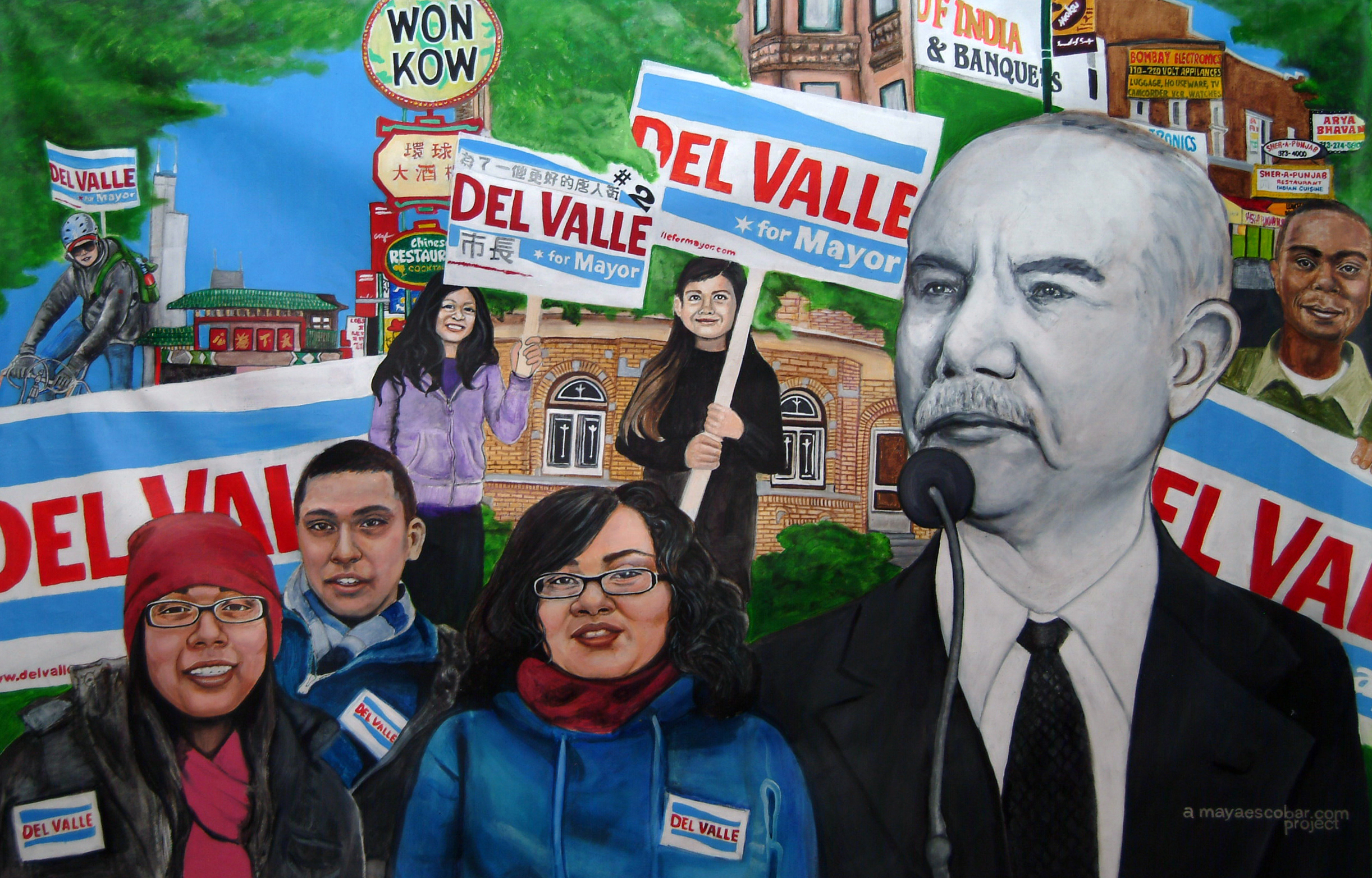 I am a Chicago-based digital media and performance artist. I created this grassroots, social media, portable mural in support of Miguel del Valle's campaign for Mayor.
I am a Chicago-based digital media and performance artist. I created this grassroots, social media, portable mural in support of Miguel del Valle's campaign for Mayor.
follow hashtag: #delValleMural to see how the mural was created.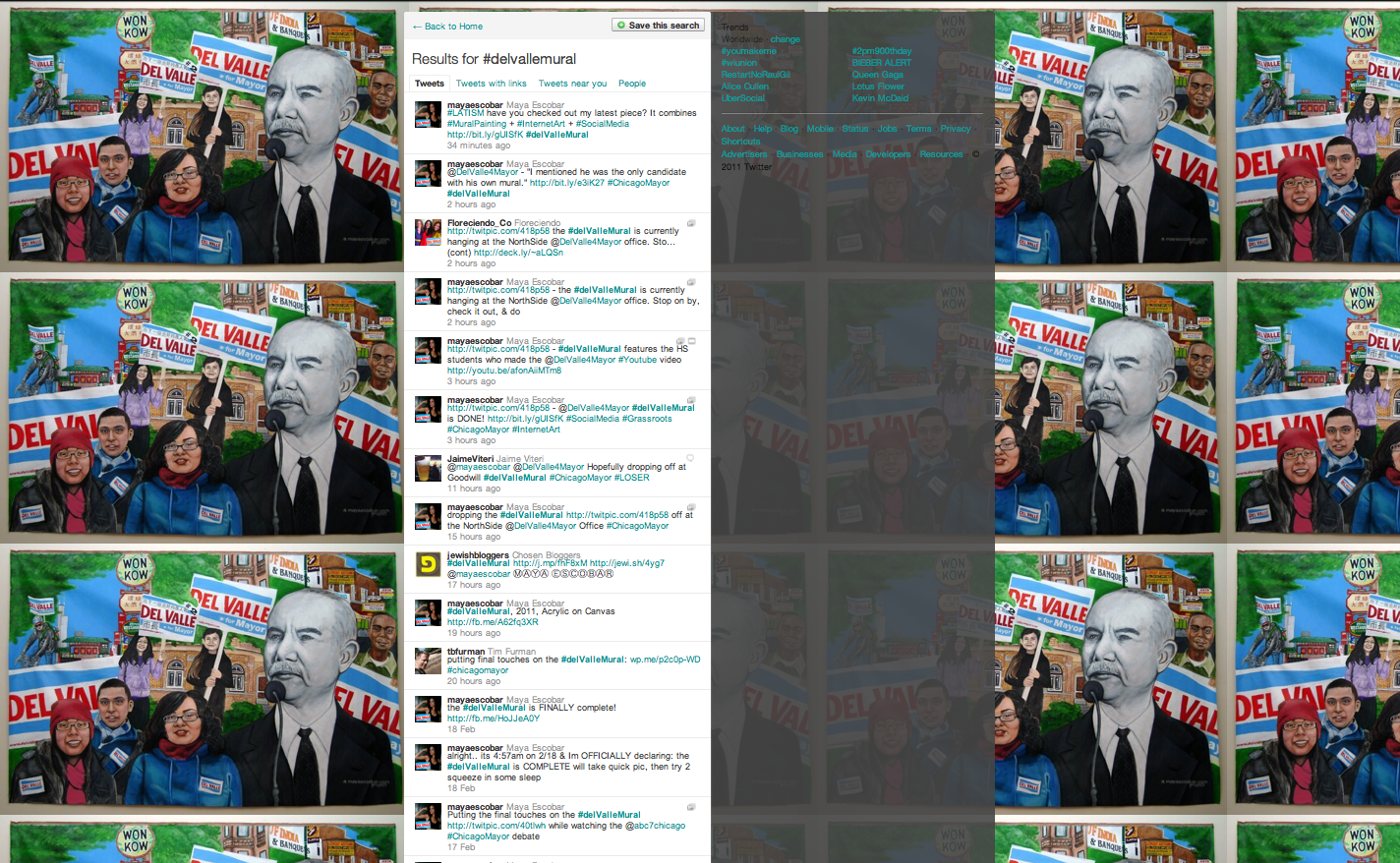
YouTube Video Reel
AM and I are applying to another residency!Unlike our current Wonder Woman Residency, where we applied as Escobar-Morales, this particular program does not accept joint proposals. So we are submitting seperately and hoping (and hoping and hoping) we will both be accepted.I am applying to the #InternetArt section.[youtube=http://www.youtube.com/watch?v=bk54gsndAQY]And she is applying to the Photo section.
Why did you have to pick this weekend to be a Chicano?
 Mayra Ramirez makes my heart pitter patter....(here is a repost of one of her latest posts on her blog Hella Breezys)
Mayra Ramirez makes my heart pitter patter....(here is a repost of one of her latest posts on her blog Hella Breezys)
It's hard for me to fully express my disappointment and frustration with Arizona's law makers... last week they passed HB 2281 witch bans "Ethnic Studies" in the states K-12 grade classrooms. I cannot emphasize how important it is to be able to learn about the history of our peoples, of our ancestors, and to be able to find pride and empowerment in that. It's such a sad and scary time in both Arizona and the country. Here is a great article about HB 2281 that I found very interesting...
So now I want to share my favorite Save by the Bell episode where Slater finds his Chicano Power!!! I feel it's a great example of why having Ethnic Studies in our classrooms is so crucial...
FUCK ARIZONA'S ETHNOCENTRIC LAWS... WE NEED TO FIGHT FOR THE RIGHT TO LEARN OUR HISTORY, OUR CULTURE AND THE ACCOMPLISHMENTS OF OUR RAZA... TIERRA, JUSTICIA, Y LIBERTAD!!!
RIGHT ON MAYRA!!![youtube=http://www.youtube.com/watch?v=T0wvG3RMKPc][youtube=http://www.youtube.com/watch?v=Ih1Qmq5Ie5k]And be sure to check out her collaboration with the always amazing Rio Yañez
Gallery of Gifs pt 2
If you enjoyed Gallery of Gifs (pt 1) check out these bad boys:(click images to view posts on Are You My Other?)



Creating Resistance: Using the Arts in Challenging Racial Ideologies
I am so excited to announce that on November 5th 2010, I will be presenting at the Critical Mixed Race Studies Conference, Emerging Paradigms in Critical Mixed Race Studies at DePaul University in Chicago.Creating Resistance: Using the Arts in Challenging Racial Ideologies A Roundtable Discussion Moderated by Laura Kina with Alejandro T. Acierto, Maya Escobar, Tina Ramirez, and Jonathan ReinertDePaul University Student Center | 11/5/2010 | 10:15 amCONFERENCE IS FREE & OPEN TO THE PUBLIC CLICK HERE TO REGISTER
This roundtable focuses on the use of the arts as a strategy to discuss, challenge, and confront ideologies of race and mixed-heritage identities. The panelists involved – each of whom work in different artistic fields – will present their work either via performance or through a discussion of their current work and the process that helped produce such work. The discussion will highlight how identifications of mixed heritage have integrated, collided, or been negotiated within and through their work while also placing their work within the complex relationship between art, activism, and organizing. Additionally, the panelists will address how their creative projects have been used strategically within specific contexts while also reflecting upon the reception of their work among the public. Likewise, they will address the relevance and necessity of this type of work within the “multiracial/post-racial” framework and how their work speaks to those issues to challenge racial expectations and stereotypes.As experienced cultural producers of various mediums, the panelists will also open up a forum for discussion about their own experience with specific art forms and how those mediums have presented various challenges, limitations, and problems in addressing ideologies of race. The audience will be encouraged to participate in the discussions by contributing their own experiences of using the arts critically and strategically as well as responding to the panelist's remarks and performances.
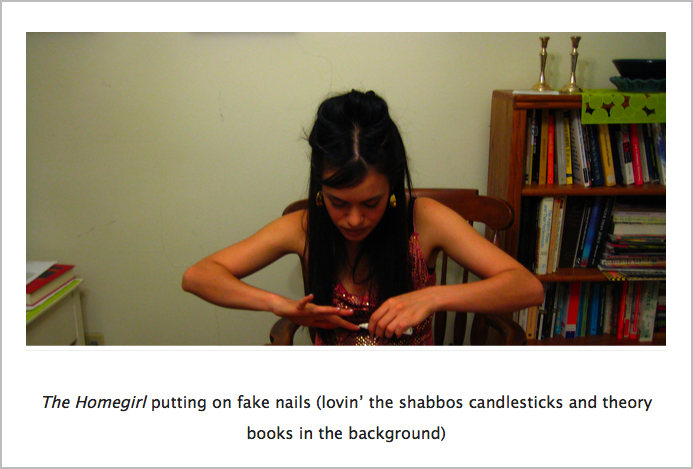 Multiple identities align in Behind The Scenes Acciones Plasticas プリクラ
Multiple identities align in Behind The Scenes Acciones Plasticas プリクラ
CREATIVE RESISTANCE ROUNDTABLE BIOSLAURA KINALaura Kina is an artist, independent curator, and scholar whose research focuses on Asian American art and critical mixed race studies. She is an Associate Professor of Art, Media and Design, Vincent de Paul Professor, and Director of Asian American Studies at DePaul University. She is a 2009-2010 DePaul University Humanities Fellow. She earned her MFA from the University of Illinois at Chicago, where she studied under noted painters Kerry James Marshall and Phyllis Bramson, and she earned her BFA from the School of the Art Institute of Chicago. Born in Riverside, California and raised in Poulsbo, WA, the artist currently lives and works in Chicago, IL with her husband, Mitch, and their daughter, Midori, and her stepdaughter, Ariel. Her work has shown internationally is represented in Miami, FL by Diana Lowenstein Fine Arts.ALEJANDRO T. ACIERTO Alejandro T. Acierto is an active collaborative musician, improviser, composer and sound artist whose innovative work in contemporary music and performance has led Time-Out New York to call him a “maverick of new music”. His creative output embraces an ambiguous aesthetic that integrates music, sound, performance art, and installation based on historical narratives and his own experience as a third and fourth generation Mexican Filipino American. He recently won the Sidney and Mary Kleinman Prize in Composition and was granted a composers’ residency fellowship at the Virginia Center for the Creative Arts. His work has also been featured by Trifecta Publishing, a curated collection of multimedia works by diverse artists.Acierto holds a Masters’ degree in Contemporary Performance from Manhattan School of Music and received his Bachelors’ degree in clarinet performance and composition with a minor in Asian American Studies from DePaul University. He has performed and presented his work in Germany, Austria, Italy, France, and across the US. He is a founding member of the New York-based ai ensemble and Chicago-based chamber orchestra ensemble dal niente and is currently freelancing in New York City.MAYA ESCOBARMaya Escobar a performance artist, Internet curator, and editor. She uses the web as a platform for engaging in critical community dialogues that concern processes by which identities are socially and culturally constructed. She performs multiple identities, sampling widely from online representations of existing cultural discourses. Her identifications as a Latina-Jewish artist, dyslexic blogger, activist and educator are indexed by the blogs she keeps, the visual and textual links she posts, the books, articles, and blog posts she cites, the public comments she leaves, and the groups she joins.Escobar received her MFA from the Sam Fox School of Design & Visual Arts, Washington University in St. Louis, and her BFA from the School of the Art Institute of Chicago. She has exhibited work in Spain, Guatemala, United States, Germany, Venezuela and Chile.TINA RAMIREZTina Ramirez is a Filipino Colombian writer, educator and youth organizer, claiming roots as a country mouse and a city mouse (Kansas-born, Chicago-bred). She has co-developed curriculum with youth spaces such as YAWP! (Young Asians With Power!) and MCYP (Multi-Cultural Youth Project), using creative self-expression as a vehicle to explore identity politics and community-based issues. She was a core organizer with Kitchen Poems, an Asian Pacific American writing workshop, and currently serves on the board for the Leadership Center for Asian Pacific Americans. She has self-published two chapbooks and performed at various venues, including Free Street Theater, Judson Memorial Church, and Insight Arts.Tina received a B.A. in Literary Studies and Creative Writing from Beloit College and an A.M. from the University of Chicago’s School of Social Service Administration with a focus on youth development, nonprofit administration and education policy. She currently works with community schools in Chicago’s Woodlawn neighborhood.JONATHAN REINERTJonathan Reinert was born in Tuguegarao, Philippines. At three and half years of age, he was adopted into a German American family in 1987. Jonathan lived in Kirkwood, Missouri for 15 years before leaving to attend college in Chicago where he graduated from DePaul University with a B.A. in Art and Art History and a concentration in painting and drawing. Inspired by the work of Vito Acconci and Chris Burden, Jonathan began experimenting with video performance art toward the end of his college career. His debut performance, "Twenty Twinkies," was a surprising success and compelled him to pursue a career in video production and documentary filmmaking.Jonathan has recently finished his studies as graduate student in Asian American Studies at UCLA. His master's thesis film, Left on Lockett Lane, is an autobiographical work which examines his experiences growing up in the Midwest as an Asian adoptee and was awarded official selection in 2010 Los Angeles Visual Communications Asian Pacific Film Festival. Jonathan will spend the remainder of the year submitting Left on Lockett Lane to various film festivals across the country and is in the process of applying to film schools for the fall of 2011.
gallery of gifs
Photo Booth Pt 2
OffLine Photos
OffLine Video Art Exhibition in Valparaiso, Chile. Photos and videos by Menru Silva
Jaime Silva, Jessica Bruna, Juvenal Barría, Cynthia Jackson, Maya Escobar, Señorita Ugarte, Paulo Fernandez, and Kenru La Hermana Gemela Altiplánica
[youtube=http://www.youtube.com/watch?v=9Dd6lV77Lrg]
el es frida kahlo
Be Wife
Offline en Chile
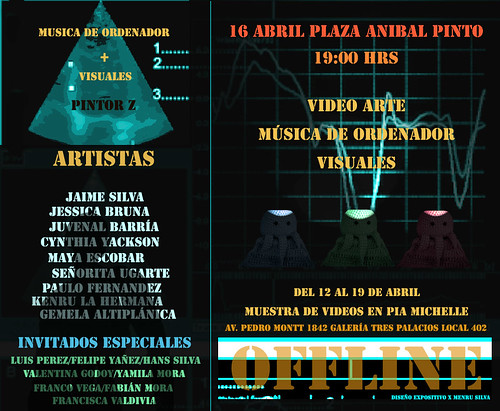 Muestra de videos en PIA MichelleDel 12-19 de AbrilAv. Pedro Montt 1842 Galería tres palacios Local 402Valparaiso, Chile
Muestra de videos en PIA MichelleDel 12-19 de AbrilAv. Pedro Montt 1842 Galería tres palacios Local 402Valparaiso, Chile
El viernes 16 de abril a las 19:00 hrs se proyectarán una serie de Videos que van desde stop motion, intervenciones urbanas y video arte experimental en la Plaza Aníbal Pinto de Valparaíso, previo a esto Pintor Z estará mostrando su trabajo con música de ordenador y visuales.Esta es una compilación de videos que se realizó a partir del proyecto denominado offline que se realizaría en el Parque O´higgins una semana antes que ocurriera el pasado terremoto , y que por causa de esto no pudo ser efectuado.La muestra busca dar a conocer el trabajo de artistas chilenos emergentes del área audiovisual experimental tomándose el espacio público y generando una intervención en si misma, además de hacer un cruce con otras miradas y culturas, en este caso con la artista de Guatemala Maya Escobar.
Photo Booth
el es frida kahlo at the gallery
el es frida kahlo is currently on view in the New Media Room at the Bruno David Gallery in St. Louis, MO.
el es frida kahlo, 2007-present
Frida Kahlo played with the identity that she wanted to project and the identity that was placed on her by others. Kahlo used her clothing, political affiliations, sexual escapades, and personal traumas, to create a character that informed her body of work. She inscribed her identity, painting her image over and over, constructing a mythology around her persona.
In el es frida kahlo I confront the ambivalence I experience as a result of my simultaneous obsession with Frida Kahlo and weariness towards her commodification. Viewed from a tiny pinhole, dressed as Kahlo, I stand before a reproduction of one of her self portraits. With a mixture of rage, anxiety, and complete fear, I chant “el es Frida Kahlo, ella es Frida Kahlo, el es Frida Kahlo, yo soy, yo soy, yo soy Frida Kahlo,” he is Frida Kahlo, she is Frida Kahlo, I am, I am, I am Frida Kahlo. As I yell, the painting behind me begins to fall. I violently tear down my braids and smudge off my makeup while continuing to scream “I am Frida Kahlo, I am Frida Kahlo, yo soy Frida Kahlo!”
[youtube=http://www.youtube.com/watch?v=0BJmaYn5IIE]
el es frida kahlo at the Bruno David Gallery (video filmed and edited by Felicia Chen)
[youtube=http://www.youtube.com/watch?v=xlMPoFXRT18]
el es frida kahlo YouTube video
FREE el es frida kahlo animated gif avaliable on MayaEscobar.com
link to translation of recent review by David Sperber in Ma’arav Israeli Arts and Culture Magazine:
Frida Kahlo at the synagogue: Maya Escobar and the young Jewish-American Creation
Latina Women Respond
Recently Latina Role Model was featured on TikiTiki Blog: stories with cultura, color and sabor, in a post by Carrie Ferguson Weir called Smart Latina vs. Sexy Latina. Carrie asked readers:
So, has your Smart Latina run up against the Sexy Latina? What do you see when you watch Maya’s video? What does it bring up for you? Why can’t we be both Smart and Sexy? Let’s talk about this, break it down, maybe shatter some stereotypes, and bust our own too.
Check out the PROFOUND difference in the nature of the comments left on this post (comments posted below) vs the ones left on YouTube.[youtube=http://www.youtube.com/watch?v=F_1X1igrL4U]my contribution to post on Tiki Tiki:
I perform over-the-top representations of different identities. I group together these representations (characters) as a means of challenging limited perspectives of what women are like, and in this case, what Latina women are like.
This character is supposed to be an intellectual, accomplished, socially conscious woman- who will forever be seen as the “Sexy Latina.” The low quality video blog is meant to mock scenes in movies, where the hot high school teacher walks down the hall and all the boys undress her in their minds.
But I am not taking a negative or positive stance either. I want to question the role Latinas play in perpetuating this persona, and question if that is even a bad thing? Are we limiting ourselves by continuing to have this same conversation, even though the behavior persists, are we enforcing it by bring more attention to it?
I haven't always been so impartial. Out of all of the characters in Acciones Plásticas, The Latina Role Model is the one I identified with the most. My original description of the way this character was perceived by others was much more reactionary and much angrier than it is now. (see below)
The Sexy Latina© from Acciones Plásticas free (stereotype) postcard, 2007
The Sexy Latina© is an educated woman who cares about important social and political issues. She wears suggestive provocative clothing to compensate for giving up her role as a homemaker. She uses her sexuality to obtain positions in the work world.
 Latina Role Model from Acciones Plásticas プリクラ 2009
Latina Role Model from Acciones Plásticas プリクラ 2009
Over the last two years this character has really evolved. Here is the new description of The Latina Role Model, re-imagined as part of my Acciones Plásticas プリクラ collaboration with artist Rio Yañez:
The Latina Role Model is a diploma totin’ intellectual, sexy, social media goddess.
What do you think? How does the earlier description of The Sexy Latina© differ from this new description of The Latina Role Model? How do these two images relate to the Latina Role Model YouTube video?
-
Sra. López says:
This is an excellent post and an excellent video. It really does make you think.I am really not qualified to speak from a “Latina perspective” on this topic because I am Anglo. (If you read my blog, you’ll know I’m Sra. López only because I married a Salvadoran.)That being the case, I can’t speak from personal experience on Latina stereotypes, but I would like to contribute an opinion or two on topics that are pretty closely related.For example, it really bothers me that the Latinas picked as reporters and journalists on Univision and Telemundo seem to be more for the purposes of eye candy than to report the news and add intelligent commentary — not that they aren’t intelligent women, but I think the sexism by the head honchos over there is pretty evident, not just on the news, but on other programming as well… And English language channels aren’t always much better. I think Western women in general – no matter what their race, fight very hard to overcome the sense that we are valued more as objects of sex/beauty, than for what’s inside.It’s very frustrating and I don’t envy the difficult job many women have of raising daughters in this world. (I have 2 sons) … With my own self esteem issues, I can’t imagine what a challenge it would be to raise a girl who is confident in herself and who doesn’t let Hollywood, fashion magazines, men, or even other females, get her down.I don’t know the solution to achieving true equality, but I think talking about it all is a good start.
-
Angelica Perez says:
Very interesting…The role model I immediately identified with was the socially-conscious, smart role model, which made me realize how loaded that role is. Being an accomplished and educated Latina comes with so many expectations — the whole giving back to the community, serving your community, being a role model and mentor for others, etc. — that’s not something that an accomplished non-Latina woman has to worry about (or feel committed to).With regards to the sexy role model — I always say that there is no sexier woman than the one that exudes confidence in herself and who she is — the sexy clothes are just extras…Great conversation…
-
[...] Tiki Tiki: Stories with Cultura, Color and Sabor, thanks to post by Carrie Ferguson Weir entitled Smart Latina vs Sexy Latina. Check out the post and be sure to leave your [...]
-
Ana Lilian says:
I guess I just never even thought of myself as the Sexy Latina…but a cute one yes! LOL! But once I´m on the dance floor, then the sexy comes out and it´s all good.But,seriously, I guess I just lack the perceived-Latina sassy-ness as I´ve never felt that bias towards me.I will definitely agree with dear Sra. López that the media, especially the Hispanic media, is completely promoting the hot Latina stereotype, and not much of the smart Latina one. Why do their “news” anchors feel they need to have their breast augmented to be taken seriously?
-
Kikita says:
I think it is inherent in our culture to be “hot” in every sense of the word because we are so passionate.I love what Maya was trying to accomplish and say with her video, but I found that she couldn’t hide or deny her Latin sensuality even when she was trying to play the part of an “intellectual, accomplished, socially conscious woman.”This DID make me stop and think, but what I realized is that I tend to shoot for a 3rd type. I go for “Classy Latina.” You know, the one that can wear the big hoops and sexy top with a pant suit. Someone like Ingrid Hoffman or Karla Martinez.
-
C. Morales says:
My impression is that Latina women play into the stereotype because Latino men often expect them to, and they are threatened by a smart woman. It is not just non-Latino men who expect a mujer caliente and nothing more.
-
Liz says:
How you project yourself, depends on you, no matter what. I, like Ana, never felt that I was looked at differently because I am Latina. I don’t see my self as a Sexy, Hot, Latina(I hope my husband does, though). Hell, I’m 33, been married for 12 years, and have 3 kids. I don’t get “chifles” anymore… ): LOL!This is directed towards the younger, single generation. How they present themselves as the future “Latina Generation”, depends on how they are raised. It’s up to us, as moms, to teach our daughters to go and be the BEST they can be. It’s up to me to raise my daughter to know what it right from wrong. Do guys really still think that girls are still destined to be “home/baby makers? Really??Forget Hollywood. Forget the Media. Heck, forget the evening news. If those ladies felt that they need to have their lady lumps hanging out in order to get the job, then I feel sorry for them. But, it is what it is.I will raise my daughter to know that education is the key to being classy and sexy! Not exposed Humps and Lady Lumps! Also, I will raise my boys to see women and they see themselves. Whether they marry a Latina or not.Ay, me pase de mas! he he!
-
SUZ says:
A smart and fun video commentary on the stereotypes of women in general…the educated intellectual, the hot babe, the innocent women. I like that Maya uses humor to deflect the extremes. Also that she creates a fine line between integrating the different role types. This is interesting because everyone is never just one thing…but we may choose to identify one way.
-
Melissa Garcia Logan says:
I think it’s part of a male dominated culture. Many women have this problem of having to manage male expectations in their professional lives, whether it is living with objectification or men projecting their need for nurturing from any woman they meet. I’ve had jobs where men thought it was okay to flirt with me and expected me to fulfill some messed up hot secretary fantasy, and I’ve had jobs where men I worked with expected me to be maternal and when I was driven, I was labeled aggressive. I’m not a dog, I’m not a hooker, and I’m definitely not your mother, guys.I think we have to teach men when they’re children that women can fill many roles and to expect them to be as capable and androgynous as any man performing the same duties. By the same token, I don’t know how I feel about using gender or sexuality as an asset to get ahead, my feeling is that anything you do that is manipulative in nature, is skirting unethical, if not flat out crossing the line.Having a sense of humor about stereotypes though, I don’t know if I see a problem as long as you don’t go too far and reinforce them. If it’s clear it’s a joke and part of the joke is how ridiculous stereotypical behavior really is…
-
 Carrie says:
Carrie says:I love the feedback, ladies. All great points and fabulous reflection.I am left wondering this, after reading Ana and Liz’s comments: Is stereotype/perception felt/seen at a greater level when we don’t live in predominately Latino communities?This comes to mind because your comments made me realize I never thought too much of my Latina side and my American side until I lived in cities where there weren’t a bunch of Cubans running around me everywhere. My otherness was apparent and pointed out. It was almost like, wow, I am different?Interesting!
-
Marta says:
I don’t fit into the Sexy or Brainy Latina mold at all. Probably because I look very Anglo – light skin, blue eyes. I blend pretty seamlessly into my So Cal suburban life.Except for the Latina “chispa.” That’s always the big giveaway right there. =D
-
Liz says:
Carrie,I emailed your post to my niece, whose studying at Penn State, this is what she had to say:Well, I agree with her lol. A lot of people especially here in Pennsylvania, see me as exotic because I’m Hispanic. They expect me to speak Spanish all of the time and a lot of them expect me to be kinda stupid and slutty. But when people get to know me, they find out that I’m extremely smart. Smarter than most people they encounter. And it sucks because I’m always having to prove myself to people and to teachers. But in the end, I’m the one that’s dropping jaws for my intellect and not for my attractiveness =)The end haha. Hope that helps.I am one PROUD Tia!!! (:
-
 Carrie says:
Carrie says:Liz, aha! Thank you for sending the post to your niece and validating my theory. I love how your niece wrote to you and the “stupid and slutty” line made me bust out laughing — especially because she obviously is not.Gracias, proud Tia!(Maybe she needs to write for the Tiki Tiki? hmmmm?)
-
Veronica says:
Great video and excellent points.I think that this expectation for Latinas to appear sexy is one reason why I reject the hot mom movement. I wish there was just as much social pressure to be smart Latinas, smart moms, smart women as there is to be hot, sexy, etc.
Latina Role Model on Tiki Tiki
Latina Role Model is on Tiki Tiki: Stories with Cultura, Color and Sabor, thanks to post by Carrie Ferguson Weir entitled Smart Latina vs Sexy Latina. Check out the post and be sure to leave your responses!
free el es frida kahlo animated gif
el es frida kahlo will be on view at the Bruno David Gallery in St. Louis, MO from 1/22-3/6. In conjunction with the exhibition, I am offering a FREE embeddable animated el es frida kahlo gif on mayaescobar.com.
behind the scenes acciones plásticas purikura
Here are some behind the scenes images from the many Acciones Plásticas プリクラ photo shoots.
The Latina Hipster
The Homegirl
The Homegirl putting on fake nails (lovin' the shabbos candlesticks and theory books in the background)
The Avodah Girl
The 612er
---------------------------------------------------------
Check out this inspiring write-up on Acciones Plásticas プリクラ on Truth and Healing Project.excerpt below:
goodness. I’ve been thinking a lot about the intersections between new media and traditional forms of knowledge and how these intersections can be ways of supporting tradition, innovation, resistance and liberation. As a media-maker, I’ve thought a lot about non-traditional forms of telling stories and the value of stories to allow us as individuals and communities to grow and remain in movement. I want to both honor our traditions and create space for challenge in order to support growth. This is particularly challenging when, as indigenos, we are usually FORCED into the frozen stance (as my sister Whisper says) of the “American Imaginary”. Born out of a flat analysis, the “American Imaginary” boxes us into specific archetypes and narratives that, though perhaps grounded in truth, metaphorically and at times literally “freeze” us and immobilize us from engaging in healthy movement and LIFE. As a guatemalan-born/ mixed -id’d/ mayan-adoptee I’ve dreamed about new and innovative ways to create forums and craft form that embodies the intersections of say, mayan id, transracial queer, working class, single teen mama id. For example, as a queerasfuck femme I’ve LITERALLY dreamed of beginning a series of corsets created out of huipil’s with stories attached to each… though I have yet to begin work on that. I am so excited by the thoughts of spaces for dialogue, beauty, challenge & examination of the COMPLEX identities embodies by the our contemporary indigena communities. . Fierce and phenomenal chicana and radical latina artists have had HUGE impacts on me but I’ve been hungry to see this come from other guatemelan/ mayan artists. Today, I got a taste of a contemporary and GUATEMALAN artist who is actively engaged in a similar examination! I came across this blog (and art work) and it was as if an answer was given to me in the form of possibilities. A sweet affirmation that this form of mayan/guatemalan art CAN and DOES exist.
CHAP OPENING 12/6
Show opens 12/6. If you haven't seen it, check out guest post I did on MyJewishLearing.com about my father's and my piece in the show.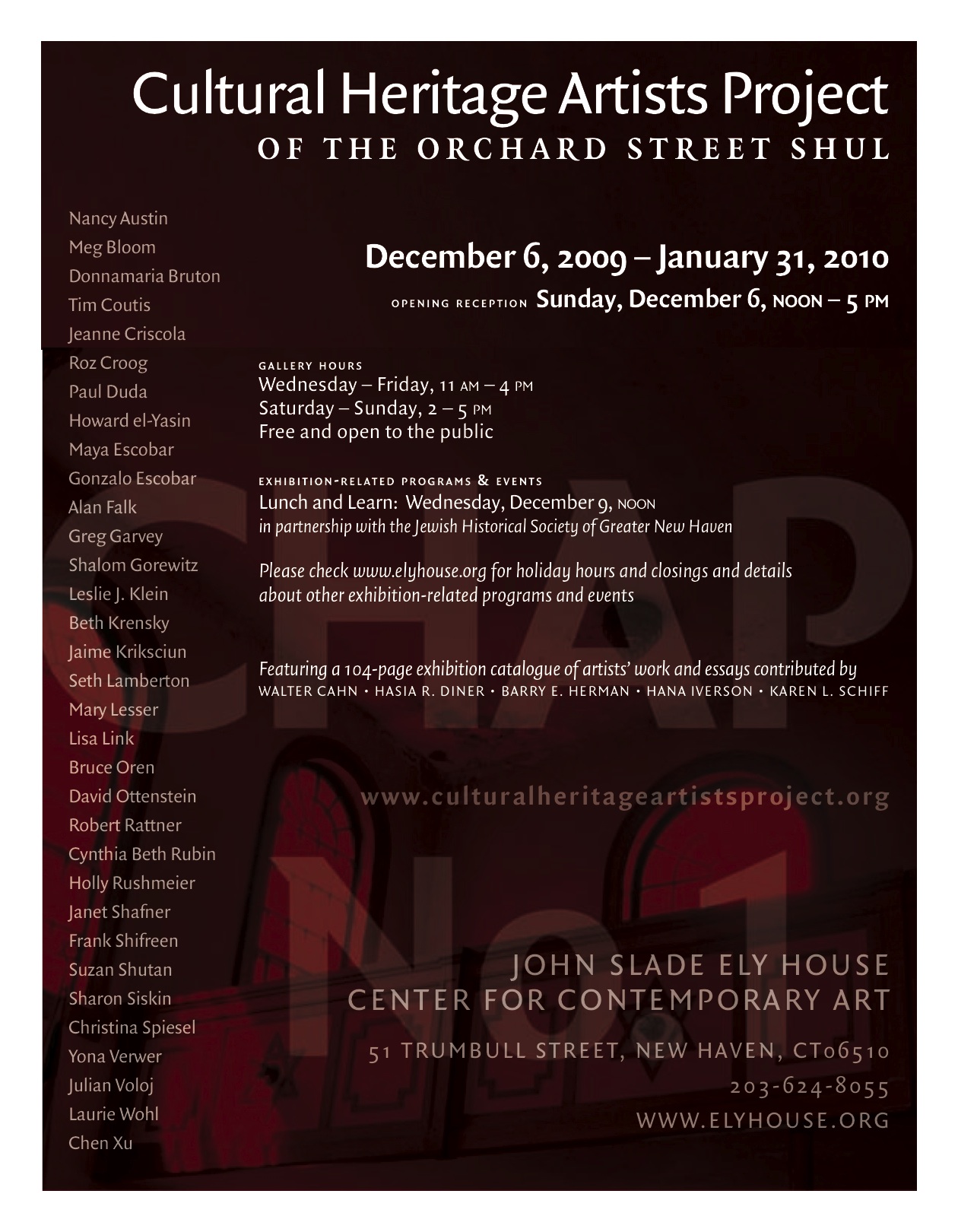
a guest post by seenoga
a guest post by seeNoga.
As you doggedly pursue, chase, and snap at the heels of your Self, you do so knowing there is no chance you will ever catch up. For each of us, throughout our individual lives, we will be ever distant from knowing our own selves. When a person pursues his or her Self in an aggressive, determined way, the resulting hyperactive sensibility allows for a greater adaptability and sensitivity. This flexibility can be useful in contemporary human life, but only to a certain extent. It is also due to the fast-paced nature of today’s engineered environments, that there is a strong tendency (especially among young people) to go to extreme lengths in order to sustain within their own lives the hyperactivity and intensity they witness in popular culture and media. Consider the called-for constant reachability via cell-phones and laptops, as well as many other forms of expedition in our ‘lived-in’ world. These accommodations range from aerodynamics to ATMs. As many workers in today’s professional world simultaneously lament and extol their parasitic relationships with a Blackberry or other such Pocket God, I, too, have at many times felt chained to my laptop (i.e. the Internet), fearing I would miss something absolutely critical. Unfortunately, the fact that missing anything important has not happened for the most part, hardly affects the worry and anxiety that it might happen.Yet still, it seems, this once motivating anxiety is becoming a repressed urge, one which is less and less a bother, the more my environment becomes one seamless, semi-omniscient “news” feed. On the evening of President Barack Obama’s Address to the Nation, Maya Escobar recorded “Obama Tweet: How a New Generation Gets Their Information.” In this video Escobar documented a particular event, an important cultural event, one which incidentally brought the use of Twitter to the fore in popular culture.[youtube= http://www.youtube.com/watch?v=359HwupsY1s]
Obama Tweet: How a New Generation Gets Their Information, 2008
I was with Escobar on this evening and was struck by the depth of her interaction with the digital realm. She was sitting in front of a T.V. broadcast of the speech, while she was also further mediating that media via her computer, on which she was following Twitter and CNN.com’s coverage of the event. Beyond all that, Escobar was creating her own real-time, indexical document of the event on television along with CNN and Twitter as instantaneous forms of annotations to the President's speech. Escobar was watching, sitting one more stage removed, behind the lens of a video camera. Because of the way in which she layered the television screen the computer screen and then the interface of any viewer's monitor, Escobar has effortlessly choreographed a multi-layered, engagement with the very most current of events. However, though I may have somewhat qualified and rationalized instant-communication tools, I still believe there must be a deliberate effort to complement those socially-prescribed media with other, independent forms of digital exchanges. While I do believe in the great social potential of our rapidly advancing communications media, my work seeks to push and pull on parts of these evolving global ‘informachines,’ in an effort to challenge the omnipresence of commercial media.[youtube=http://www.youtube.com/watch?v=d0ZvYQOp89I]
Look Out, 2008
That sort of layering of non-dimensional spaces is unique to the contemporary world, with the inception of digital technologies, and this collage-like aesthetic is of great interest to the work of Maya Escobar, as much as it is to my own. Although, unlike the deceptively referential works of my counter-part, in many of my works, I use and refer to popular media sources and specific Internet sites indirectly and rarely with any superficial visibility. It is with great deliberation and much hypothesizing that I curate my works in the manner in which I do. I intend my works to avoid specificity and leave wide-open their readings to a much more self-guided analysis by viewers. In the piece “Look Out,” the projected video came directly from YouTube. I simply cut off the last second of the original video, thus shortening it to 17 seconds. I then prepared it as a video-loop for its installation underneath a staircase at the Mildred Lane Kemper Art Museum. Because of its placement, where it fills a theretofore, unaddressed space, it is as though the rolling image is part of the museum structure itself. The particular clip, which I chose after viewing dozens of similarly tagged videos (‘storm,’ ‘tree,’ ‘willow,’ and ‘weeping’), was selected for very specific compositional reasons; reasons which are the very same principles of design taught to anyone working in commercial design or the visual arts: complimentary colors, rule of thirds, dynamic composition and varied textures, to name a few. Because of my focused selection process, this video, although created for very different (and unknown) reasons, still fits very well into the installation space as a deliberately designed, and potentially permanent use of what is otherwise a neglected space. The video became part of the stairwell. By existing within a predetermined, architectural frame, it became part of the space, as opposed to sitting on the surface as a painting does. This projection did not exist in the way that many (most) installations do: as obvious alterations or obtrusive interjections into a space. This work asserts itself as a physical part of the space, as the projector beams through from behind the scrim in the stairwell. It also assumes a living presence, as it reiterates itself, by many reflections and refractions, split and scattered, bouncing around the main hall of the museum. The video functioned as a decorative element but also an illusory window to an outside world, whereas, the space without that piece is simply a pane of glass that looks into the shadowy crotch of a stairwell. I do not mean every square inch should be taken up for some sort of visual activity or illusionary window. Simply, this work proposes how our constructed spaces, in this case a venue for art viewing, might be reinterpreted. Insofar as, a corner can conceivably become a window, as illusory and impermanent as my particular interpretation may be.
*NOESCO is seeNoga and maya escobar
acciones plásticas goes プリクラ chicano style
Acciones Plásticas プリクラ
Acciones Plásticas プリクラ is a collaboration between artists Maya Escobar and Rio Yañez.
 The Latina Hipstera bad-ass Morrissey-lovin’, tuff-girl sexy chica
The Latina Hipstera bad-ass Morrissey-lovin’, tuff-girl sexy chica The Latina Role Modela diploma totin’ intellectual, sexy, social media goddess
The Latina Role Modela diploma totin’ intellectual, sexy, social media goddess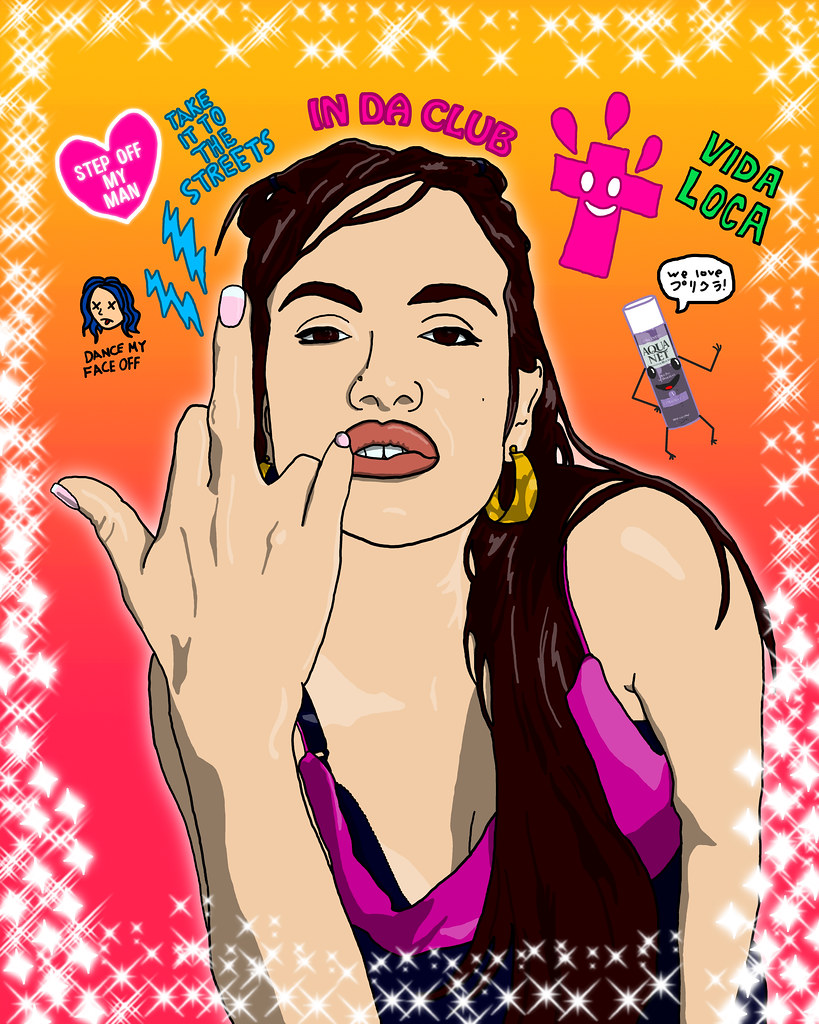 The Homegirla hybridized version of Escobar’s Midwestern Chach and Yañez’s West Coast Chola.In Acciones Plásticas Escobar created a multi-faceted “doll” by assuming the role of designer and distributor, and even posing as the actual doll itself. Each doll was a satirical characterization of some of the many roles that have been projected upon her, and into which she has, at points, inevitably fallen. In conjunction with these images, she developed a short series of low-definition youtube video blogs through which she inhabits the lives of “real women” who have each been visibly defined by societal constructs.Recently, Yañez has been utilizing Japanese photobooths (known as Purikura or “print-club”) as an artist’s tool for creating portraits. These booths are much more common in Japan than their United States counterparts. As a catalyst for creative expression and social interaction they are used primarily by young urban Japanese girls. A standard feature in all Purikura booths allows the user to digitally decorate their portraits after they take them. The options are vast and include wild characters, excessive starbursts of light, pre-made phrases and the option to draw your own text directly on the image. Purikura gives the subjects near-divine powers of self-expression in crafting their own portraits.The two artists who met over the web, decided to bring together Escobar’s highly charged and evocative Acciones Plásticas characters with Yanez’s notorious Chicano graphic-art style and new found obsession with Purikura images, as a way of addressing the construction of Latina identities.Maya posed as The Latina Hipster: a bad-ass Morrissey-lovin’, tuff-girl sexy chica; The Latina Role Model: a diploma totin’ intellectual, sexy, social media goddess; and finally, The Homegirl: a hybridized version of Escobar’s Midwestern Chach (or Chachi Mama) and Yañez’s West Coast Chola. Maya sent digital images to Rio, who in turn drew portraits of her as each of these constructed identities. He approached each portrait with a Purikura sensibility and decorated them each as the characters represented might accessorize themselves. The final series of portraits is the result of negotiating multiple identities and influences. Guatemalan, Jewish, and Chicano sensibilities reflected back through a Japanese Purikura aesthetic. Acciones Plásticas プリクラ challenge and question the thin line between archetype and stereotype. The Purikura elements present the novel signifiers of each social construct represented in the series.This collaboration is the first of many to come as Maya and Rio explore the commonalities and differences of their cultural identities.For more information on Acciones Plásticas プリクラcheck out Rio's blog and stay tuned for guest post by seeNoga aka Carianne Noga on meeting the Chach Homegirl in real life.(video of the Chach featured below)[youtube=http://www.youtube.com/watch?v=Xj3Q42YF40Y]
The Homegirla hybridized version of Escobar’s Midwestern Chach and Yañez’s West Coast Chola.In Acciones Plásticas Escobar created a multi-faceted “doll” by assuming the role of designer and distributor, and even posing as the actual doll itself. Each doll was a satirical characterization of some of the many roles that have been projected upon her, and into which she has, at points, inevitably fallen. In conjunction with these images, she developed a short series of low-definition youtube video blogs through which she inhabits the lives of “real women” who have each been visibly defined by societal constructs.Recently, Yañez has been utilizing Japanese photobooths (known as Purikura or “print-club”) as an artist’s tool for creating portraits. These booths are much more common in Japan than their United States counterparts. As a catalyst for creative expression and social interaction they are used primarily by young urban Japanese girls. A standard feature in all Purikura booths allows the user to digitally decorate their portraits after they take them. The options are vast and include wild characters, excessive starbursts of light, pre-made phrases and the option to draw your own text directly on the image. Purikura gives the subjects near-divine powers of self-expression in crafting their own portraits.The two artists who met over the web, decided to bring together Escobar’s highly charged and evocative Acciones Plásticas characters with Yanez’s notorious Chicano graphic-art style and new found obsession with Purikura images, as a way of addressing the construction of Latina identities.Maya posed as The Latina Hipster: a bad-ass Morrissey-lovin’, tuff-girl sexy chica; The Latina Role Model: a diploma totin’ intellectual, sexy, social media goddess; and finally, The Homegirl: a hybridized version of Escobar’s Midwestern Chach (or Chachi Mama) and Yañez’s West Coast Chola. Maya sent digital images to Rio, who in turn drew portraits of her as each of these constructed identities. He approached each portrait with a Purikura sensibility and decorated them each as the characters represented might accessorize themselves. The final series of portraits is the result of negotiating multiple identities and influences. Guatemalan, Jewish, and Chicano sensibilities reflected back through a Japanese Purikura aesthetic. Acciones Plásticas プリクラ challenge and question the thin line between archetype and stereotype. The Purikura elements present the novel signifiers of each social construct represented in the series.This collaboration is the first of many to come as Maya and Rio explore the commonalities and differences of their cultural identities.For more information on Acciones Plásticas プリクラcheck out Rio's blog and stay tuned for guest post by seeNoga aka Carianne Noga on meeting the Chach Homegirl in real life.(video of the Chach featured below)[youtube=http://www.youtube.com/watch?v=Xj3Q42YF40Y]
Talking About Orchard Street

photo by Julian Voloj
Maya and Gonzalo Escobar create Talking about Orchard Street, a multi-sensory interactive installation that explores the generational transmission of Jewish life through dialog. The father-daughter duo traveled from Chicago to New Haven to conduct interviews with former members and friends of Orchard Street Shul and to record locals’ stories of growing up in New Haven during the 1920s and 30s. These stories of everyday life include tales of flirting on the front steps of the shul, eating herring and kichel, speaking Jewish, finding first jobs, going on first dates, learning bar mitzvah portions, and hearing (or having) loud conversations in the women’s section. In Talking about Orchard Street, visitors are invited to sit in comfortable armchairs, sample herring and kichel, listen to excerpts from interviews and engage in dialog with each other.click here for more information about the Orchard Street Shul Artist Cultural Heritage Project





